
Sikh literature is a lush landscape of nature-inspired symbolism. The disciple’s longing for the Gurū’s lotus feet is compared to the cuckoo bird’s search for water droplets. A Sikh aspires to be like the moon—stoic and unmoved by the night—illuminated and glistening from the unseen source of the Sun.
Kavī Santokh Singh (1787-1843) depicts the Tenth Master in the following passage from Sūraj Prakāś Graṅth, using metaphors of both earth and sky to render the monumentality of the Gurū’s beauty.
ਸ੍ਵੈਯਾ
ਕਟ ਸੋਂ ਪਟ ਤੇਗ਼ ਨਿਖੰਗ ਕਸੇ,
ਮੁਖ ਮੰਦ ਹਸੇ ਦਮਕੈ ਕਿ ਛਟਾ ਹੀ॥
ਮੁਕਤਾ ਗਰ ਮਾਲ ਬਿਸਾਲ ਬਨੀ,
ਸ਼੍ਰਮਸ਼ਾਨਨ ਸ਼ਯਾਮ ਭਲੀ ਉਪਮਾਹੀ॥
ਹਿਤ ਸੋਂ ਤਮ ਸੋਮ ਕਿ ਪਾਸ ਬਸਯੋ,
ਮੁਖ ਪੰਕਜ ਪੈ ਮਧੁ ਪੁੰਜ ਸੁਹਾਹੀਂ।
ਅਬ ਆਨ ਕੀ ਆਸ ਨਿਰਾਸ ਭਈ,
ਕਲਗ਼ੀਧਰ ਬਾਸ ਕਯੋ ਮਨ ਮਾਹੀ॥ ੩੦॥
ਕ੍ਰਿਤ: ਕਵੀ ਸੰਤੋਖ ਸਿੰਘ, ਸ੍ਰੀ ਸੂਰਜ ਪ੍ਰਕਾਸ਼ ਗ੍ਰੰਥ
ਅਧਯਾਯ ਪਹਿਲਾ, ਮੰਗਲਾ ਚਰਨ, ਨਾਮ ਮਹਿਮਾ ਬਰਨਨੰ, ਨਾਮ ਪ੍ਰਥਮੋ ਧਯਾਇ
(text: Braj, Gurmukhī script)
Svaiyā
With a sheath tied to his waist,
his smile shines bright like lightning.
A string of pearls adorns his neck,
and the dark of his beard is beyond comparison:
resting on his face like a group of bees gathered on a lotus petal,
or as if darkness has surrounded the moon.
When such a Gurū has settled in my heart, who else can I long for?
Kavī Santokh Singh, Sūraj Prakāś Graṅth
Chapter One, Maṅglāčaran, Exaltation of the Sacred Name
(translation: English, Latin script)

The poetics of Sikh thought inform the majority of my creative work. I formulate visual responses to written metaphors, resulting in fantastical imagery filled with mythical and magical creatures situated in illusionistic settings.
What we are interested in as children often drives what we spend our time doing as adults. My own trajectory has followed this exact roadmap. Growing up in Canada in the ethnically homogenous city of London, Ontario, my parents surrounded my brother and I with nuggets of Sikhī and Paṅjabīat whenever and however they could. This took shape through Gurdavārā involvement, frequent visits to Paṅjab, and most imaginatively of all, through storytelling.
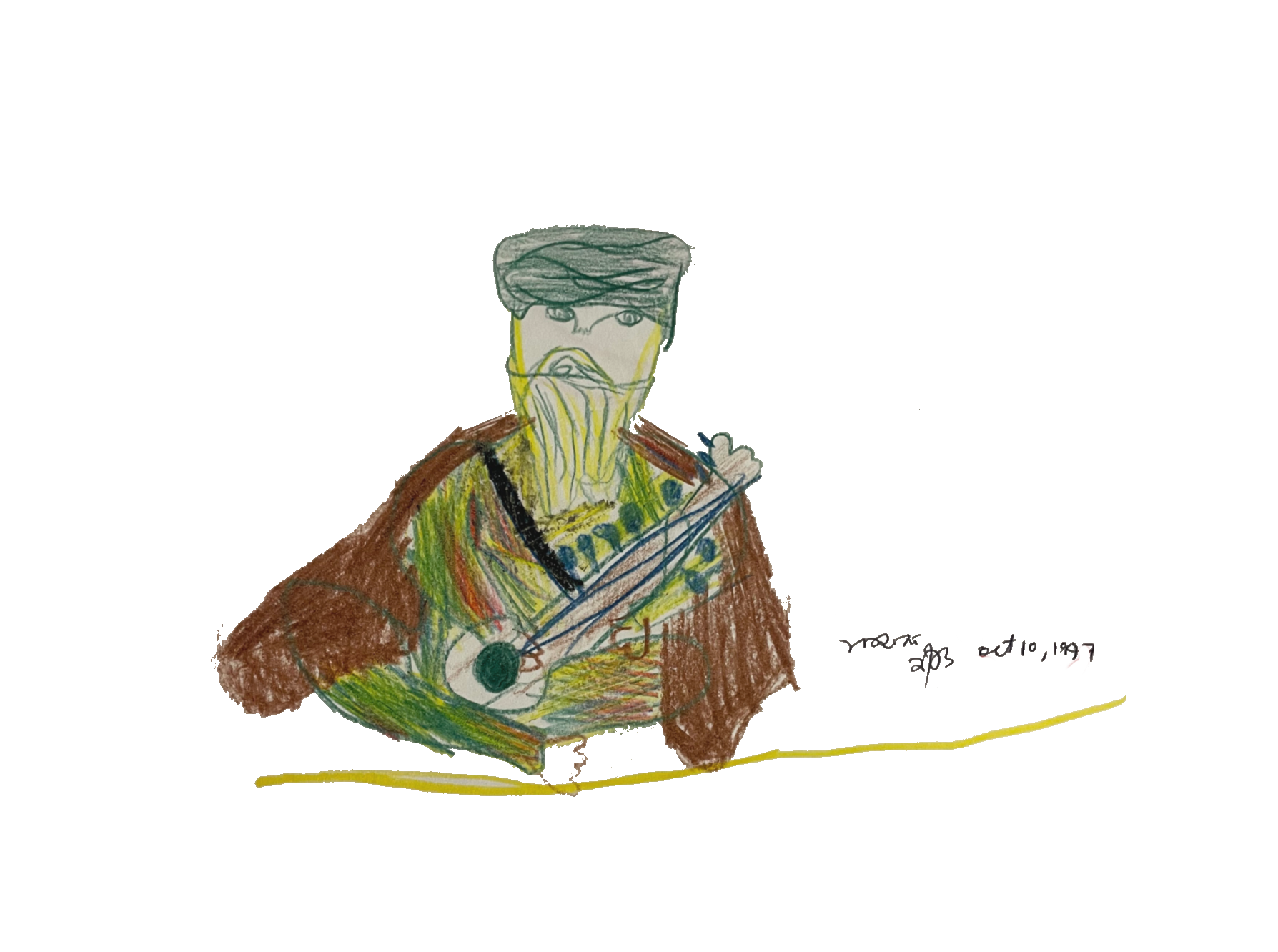
Mardana 1997, pencil crayons on paper 8.5” x 11”
When I first heard about Gurū Nanak’s best friend and his rabāb, my initial response was to materialise his image the best way that I knew how: through markers and pencil crayons. As a child, I wanted to give oral histories tangibility and permanence so that I could revisit their enchantment the same way that I did with my favourite storybooks and movies. Being surrounded and inspired by vivid animations from the world of Disney, I fashioned Bhāī Mardana a visual universe of his own. At age six, I hardly knew the difference between the rabāb and the sitār, and my first drawing of Bhāī Mardana presents him holding a hybrid of the two, collaged with the sound hole of a guitar.
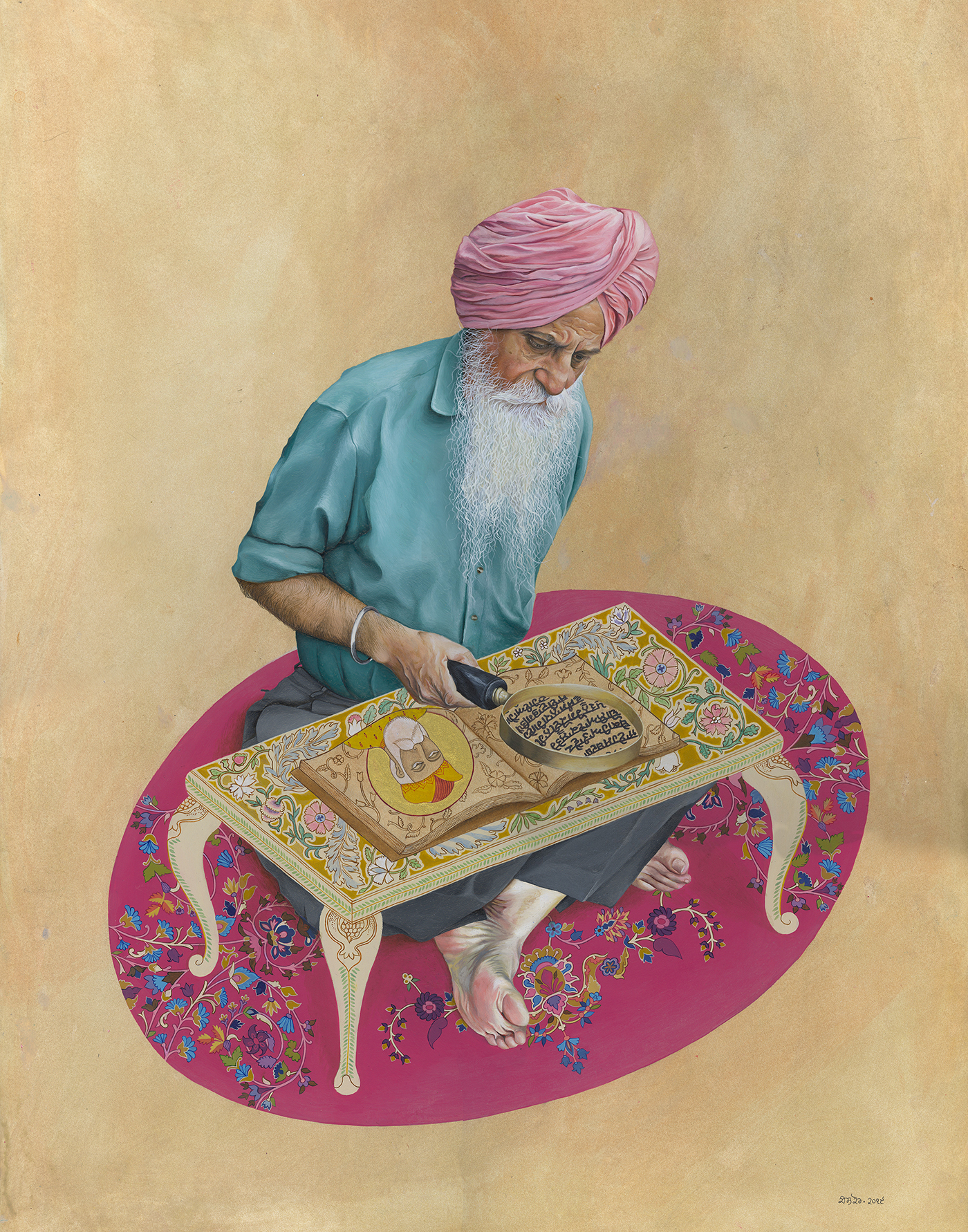
The Living Encyclopedia 2019, acrylics and oils on card 16” x 20”
The Living Encyclopedia is the totem of my visual practice. The surrealism of this work invokes a personal history. My father, Harkinder Singh, has been a collector and analyst of early modern manuscripts for the last three decades. The majority of these texts document Sikh traditions from the lens of an undivided India. It is his research and imparting of knowledge that has exposed me to the narratives that I explore visually.
This work is layered in symbolism; the magnifying glass zooms into a passage from Gurū Nanak’s Janamsākhī, and the rest of the page communicates the beauty of the writing through delicate patterns and imagery. My father sits at the centre, engrossed in his life’s passion of studying the literary nuances of these texts.
I have maintained the same penmanship as the original, handwritten Janamsākhī of Gurū Nanak authored by Bhāī Mani Singh. This includes the practice of continuous, laṛīvār writing without breaks between individual words. For clarity, here is the text in Gurmukhī-Braj with the words separated:
ਜਾ ਏਹ ਸਬਦ ਬਾਬੇ ਕਹਿਆ ਤਾੰ ਵੈਦ ਬੋਲਿਆ ਏ ਕਾਲੂ ਤੇਰੇ ਪੁਤ੍ਰ ਨੂ ਰੋਗ ਕੋਈ ਨਾਹੀ ਤੂੰ ਸੰਸਾ ਨਾ ਕਰਿ ॥
ਏਹ ਸਾਂਈ ਦਾ ਭਗਤਿ ਪੈਦਾ ਹੋਇਆ ਹੈ ॥
Pitā Kālu, Gurū Nanak’s father, is said to have summoned a doctor to examine his son. The thirteen-year-old Gurū began speaking of spiritual awakenings, which led his family to believe that he was bordering on lunacy. In short, this passage outlines the doctor’s diagnosis of Gurū Nanak after a brief exchange. The doctor informs Kālu that his son is free of ailments and has been sent by the Creator to illuminate humankind.
The hyperrealistic representation of the main figure grants the viewer a connection to the world of everyday experience. However, the figure sits in a dream void that is empty and expansive with intricate detailing in the centre. The formal effect is of an emblematic arrangement depicting introspection and contemplation; the juxtaposition of objects alchemises the theatrical quality of the poetry. The parchment texture of the background alludes to a blank sheet that invites something more to be written once creativity and inspiration have been harvested from their source.

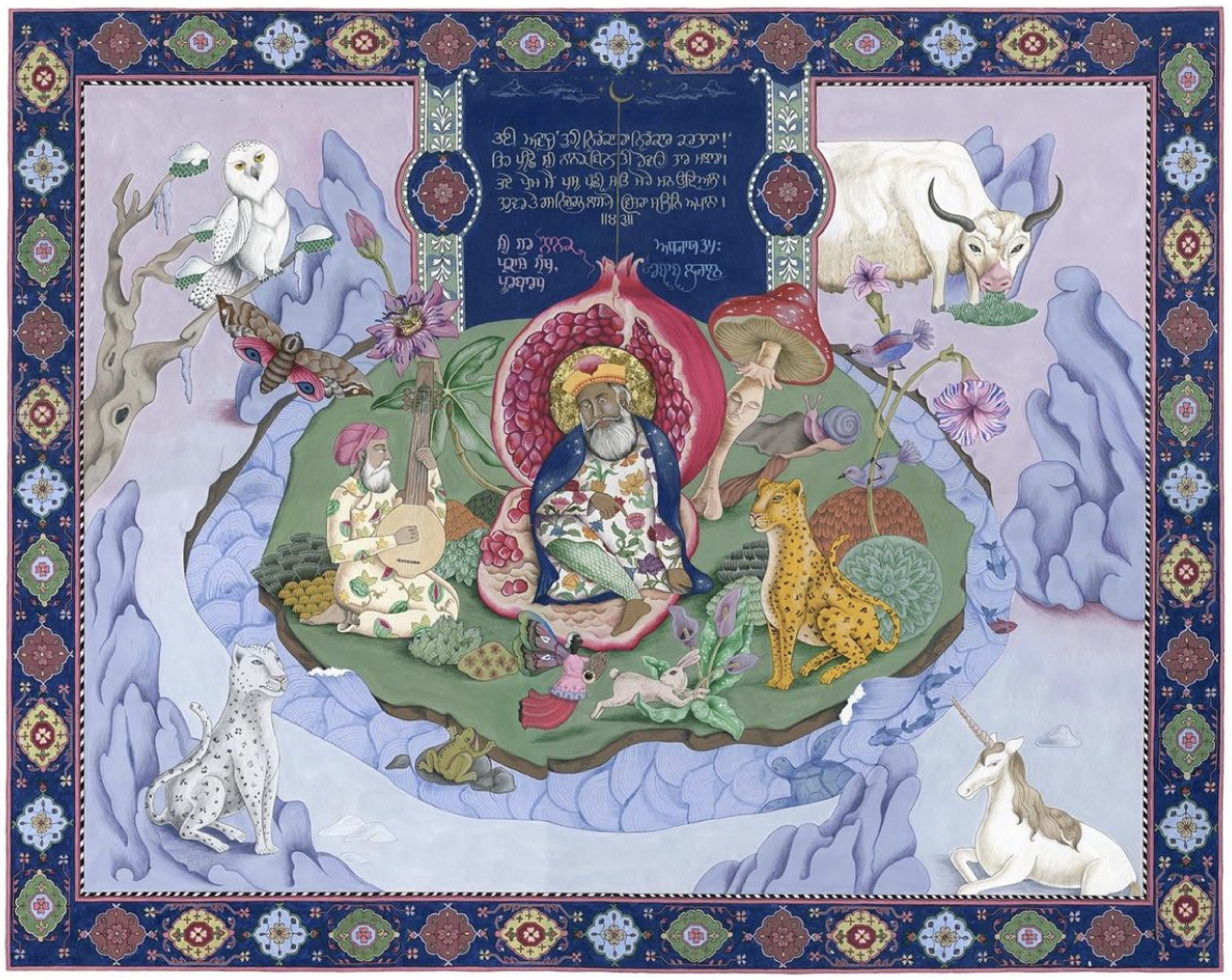
Rababi Basant 2022, gouache on card 18” x 24”
Sūraj Prakāś Graṅth has provided most of the fodder for much of my Sikh-centric work. The poetic devices with which it conjures scenes from the remembered Sikh past are particularly expressive, employing the language of fairy tales.
Rababi Basant or Rababi Spring describes the moment that Bhāī Mardana was first presented with the rabāb by Bhāī Firandā, a celebrated musician described in Sūraj Prakāś Graṅth as from the court of the heavens, from Sačkhaṅḍ. The moment that Bhāī Mardana first plucks a string is described as one that adds new colour to the surroundings. Animals brim with love, and plants engage in a delicate dance. The rabāb welcomes spring, transforming the cold of winter. Gurū Nānak would sing praises of the Creator, and Bhāī Mardāna would play the rabāb alongside him. This instrument was the final ingredient in making Gurū Nānak Dev jī and Bhāī Mardānā jī the sacred duo that gifted the world Gurbāṇī Kīrtan.
Bringing a visual dimension to written metaphors further grounds them in the phenomenal world, problematizing both workaday notions of reality and the deeper meaning of such language. These snapshots reject the idea that such descriptions are purely figurative. The realism with which objects are represented invites viewers to spot the familiar and envision themselves within these imagined spaces. The spring island in Rababi Basant blurs the lines between animate and inanimate, spinning a web of mystery, enchantment, and wondrous states of being.
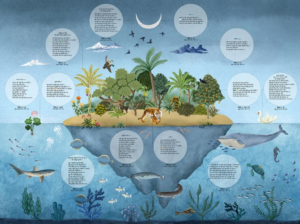
Aad Granth Biome 2019, digital drawing
Srī Gurū Graṅth Sāhib provides me with spiritual wisdom, raising further questions regarding the visual possibilities rooted in its complex metaphors. In Aad Granth Biome, I have taken the written word of Gurbāṇī and interpreted it through an image that is both illustrative and diagrammatic. This piece offers a novel way of visualising and experiencing Gurbāṇī: through the fantastical aesthetics of the picture book merged with the didactic nature of the textbook. Aad Granth Biome highlights, with both imagery and text, twelve of the recurring references to nature in Srī Gurū Graṅth Sāhib—from forests on land, to rain clouds in the sky, down to fish in the sea. All twelve texts in the drawing have unique authors, including all six Gurū-s who contributed their hymns to Sirī Gurū Graṅth Sāhib as well as six of the Bhagat-s: Kabīr, Farīd, Dhannā, Sādhanā, Nāmdev, and Ravīdās.

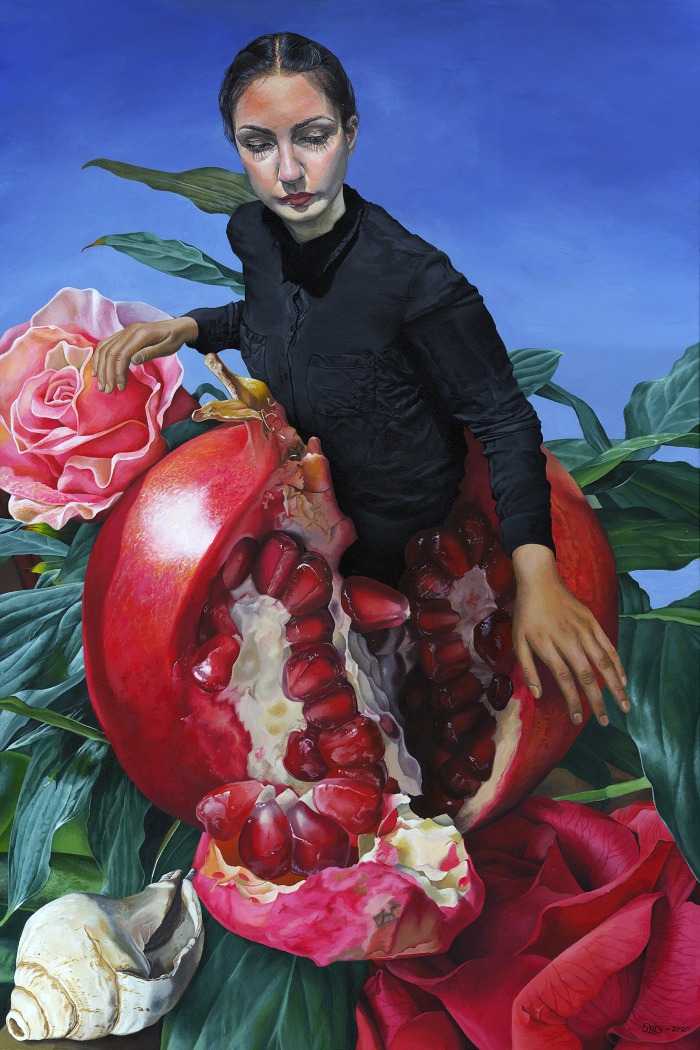
Origin Story 2020, acrylics on canvas 2’ x 3’
Sikh poetics have generated a lexicon of recurring visual motifs that have inspired how I formulated my own glossary of tropes and surrealist narratives. Origin Story reveals nature as a source of my creative power. Like the pomegranate, symbolism is often layered and complex. This painting is a surrealist representation of the richness of the pomegranate as something beyond a simple fruit, treating it as a source of inspiration for poetry and design.
The pomegranate is a testament to the origin of much of my work, and it plays with scale to convey the sizable role the fruit plays in my life. Pomegranates exhibit aesthetic beauty, deliver health benefits, and can evoke mysticism. I have had a lifelong attachment to this fruit as it was a delicacy during my visits to India. Upon seeing a pomegranate, my synesthetic interpretation is of maroon rubies surrounded by a crimson marble encasing. The physical similarity to stones and minerals connects pomegranates to opulence and fortitude. Pomegranates can be dangerous. If one is not not careful, the juice can leave a permanent stain. Pomegranates are not as easily accessible as many other fruits; strength and patience are required to peel through their thick skin to reveal the juicy seed arrangement. There is more than what meets the eye with this fruit. Although it has a rounded, hexagonal husk, not unlike many common fruits, there is a whole world of intricacies and patterns within. Pomegranates have been poeticised for centuries, and my work seeks the depths to which this can be explored. My aim is to build upon the potential for pentimento in all symbols, drawing on historical usages and adding to their stories with each new project.
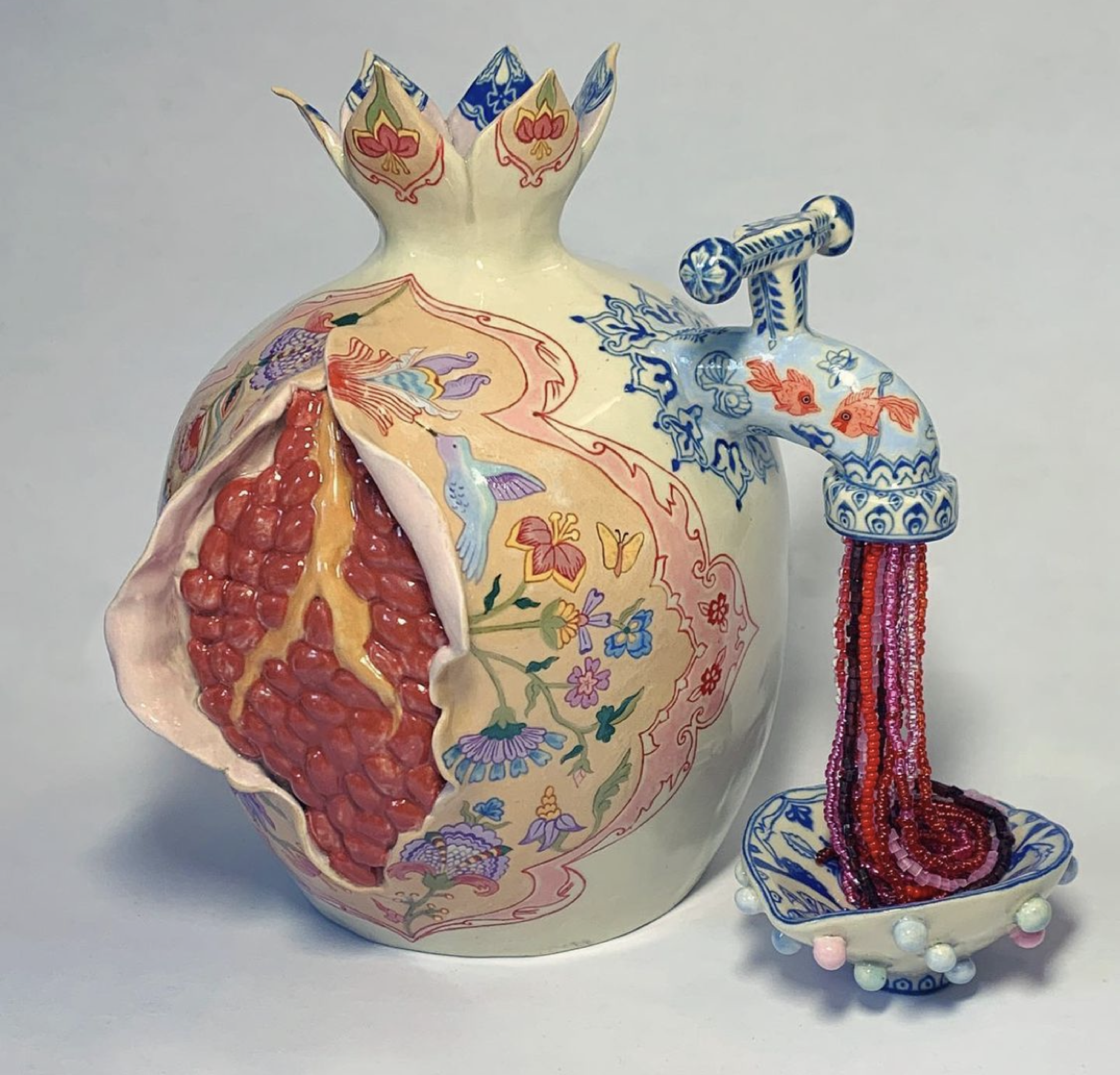
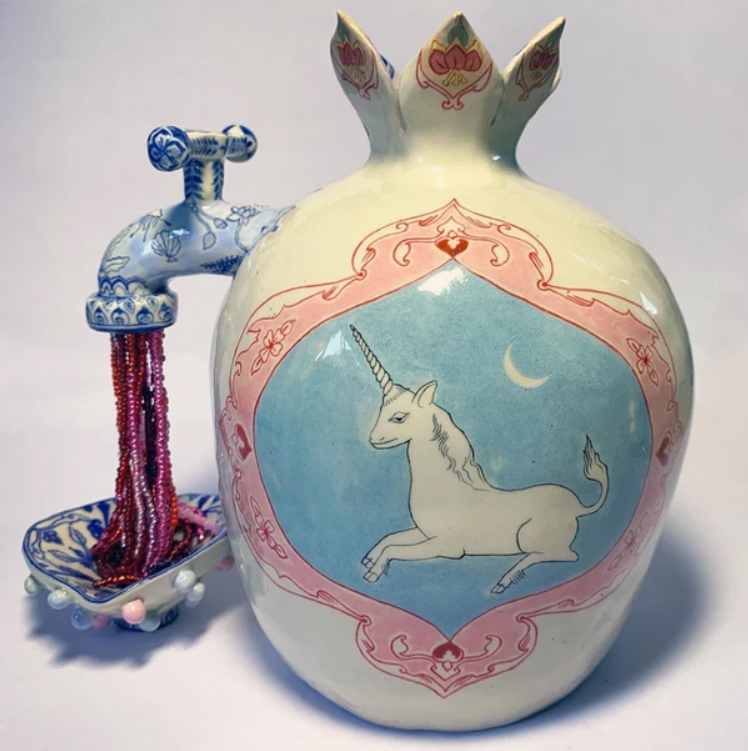
The Source 2020, hand-built and hand-painted cone 6 stoneware clay with glass beads on cotton thread ~7” x 7” x 7”
The Source looks to the pomegranate and to nature, as a whole, as a source for artistic output. It is an extrapolation from and evolution of the symbolism within Origin Story. This sculpture merges natural and mechanical elements to imagine a novel invention. Its magic is the bounty of nature, but it uses technology to extract it through the machinery of the tap. The shimmering glass of the beads is an allegory for the red juice, which is a further metaphor for the ideas that flow from this source. The sculpture is adorned with stylised patterning as a way of celebrating the ostentation and beauty of the fruit, while echoing decorative patterning used to embellish utilitarian ceramics. The undulating form of the sculpture required immense precision and patience in rendering these patterns. The unicorn on the rear of the piece is a creature from dreamlike realms. She does not exist in the material world, much like this fantastical beverage dispenser itself.

As an Artist with a background in architecture, as well as rigorous training in the field of music, I have always had a natural propensity towards expressing myself through diverse artistic modes. Each tool influences and polishes the other. My musical training and practice helped introduce an unfettered flow into my visual art practice, and my education in architecture instilled technical refinement and spatial awareness into my musical renditions. This frequent ‘medium-hopping’ opens up distinct pathways in the brain that inevitably augment all the activities in one’s life, artistic and otherwise. Energised by the symbolism and metaphors within Sikh thought, I have examined the depths to which this symbolic world of meaning can be explored across a wide range of media. I aim to continue investigating this poetry and its diverse storytelling tactics while also examining how the physicality of different mediums can elaborate on the same concept while deepening its interpretation.

Excerpt from Bandi Chhor 2020, gouache on card 16” x 20”
_____
Keerat Kaur
